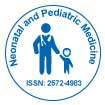Contrasts among Grown-Up and Pediatric Medication
Received: 21-Jan-2021 / Accepted Date: 04-Feb-2021 / Published Date: 11-Feb-2021 DOI: 10.4172/2572-4983.1000199
Keywords: Pediatrics, Neonatal, Preterm
Introduction
Pediatrics is the part of medication that includes the clinical consideration of babies, youngsters, and teenagers. The American Academy of Pediatrics suggests individuals be under pediatric consideration through the age of 21. Overall age cutoff points of pediatrics have been moving up year over year. Pediatricians work in clinics and kids' emergency clinics especially those working in its subspecialties (for example neonatology), and as outpatient essential consideration doctors.
The body size contrasts are resembled by development changes. The more modest body of a baby or child is considerably unique physiologically from that of a grown-up. A typical aphorism is that kids are not just "little grown-ups". Pediatric physiology straightforwardly impacts the pharmacokinetic properties of medications that enter the body. The assimilation, dispersion, digestion, and disposal of meds vary between creating kids and developed grown-ups.
Retention
Many medication retention contrasts among pediatric and grownup populaces rotate around the stomach. Youngsters and youthful newborn children have expanded stomach pH because of diminished corrosive discharge, in this way establishing a more fundamental climate for drugs that are taken by mouth. Corrosive is fundamental for corrupting certain oral medications before foundational assimilation. In this manner, the ingestion of these medications in kids is more prominent than in grown-ups because of diminished breakdown and expanded safeguarding in a less acidic gastric space. Youngsters additionally have an all-inclusive pace of gastric exhausting, which eases back the pace of medication retention.
Medication retention additionally relies upon explicit compounds that interact with the oral medication as it goes through the body. Supply of these catalysts increment as youngsters keep on building up their gastrointestinal lot. Pediatric patients have immature proteins, which prompts diminished digestion and expanded serum convergences of explicit medications.
Level of absolute body water and extracellular liquid volume both lessening as youngsters develop a lot with time. Pediatric patients accordingly have a bigger volume of appropriation than grownups, which straightforwardly influences the dosing of hydrophilic medications, for example, beta-lactam anti-toxins like ampicillin.
This article is an attempt to showcase the implications of these deleterious habits in children.
Digestion
Medication digestion fundamentally happens by means of compounds in the liver and can fluctuate as indicated by which explicit proteins are influenced in a particular phase of advancement. Stage I and Phase II compounds have various paces of development and advancement; contingent upon their particular instrument of activity (for example oxidation, hydrolysis, acetylation, methylation, and so on) Protein limit, leeway, and half-life are largely factors that add to digestion contrasts among youngsters and grown-ups. Medication digestion can even vary inside the pediatric populace, isolating youngsters and babies from small kids.
Disposal
Medication end is principally encouraged through the liver and kidneys. In babies and small kids, the bigger relative size of their kidneys prompts expanded renal freedom of meds that are wiped out through pee. In preterm children and babies, their kidneys are slower to develop and subsequently can't clear as much medication as completely created kidneys. Illnesses that adversely influence kidney capacity can likewise have a similar impact and subsequently warrant comparable contemplations.
Acknowledgement
None
Funding information
The authors declare that no funding source was utilized.
Competing interests
The author declare that they have no competing interests.
Citation: Alex D (2021) Contrasts among Grown-Up and Pediatric Medication .Neonat Pediatr Med 7: 199. DOI: 10.4172/2572-4983.1000199
Copyright: © 2021 Alex D. This is an open-access article distributed under the terms of the Creative Commons Attribution License, which permits unrestricted use, distribution, and reproduction in any medium, provided the original author and source are credited.
Share This Article
Recommended Conferences
42nd Global Conference on Nursing Care & Patient Safety
Toronto, CanadaRecommended Journals
Open Access Journals
Article Tools
Article Usage
- Total views: 1620
- [From(publication date): 0-2021 - Apr 03, 2025]
- Breakdown by view type
- HTML page views: 911
- PDF downloads: 709
